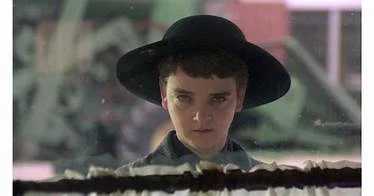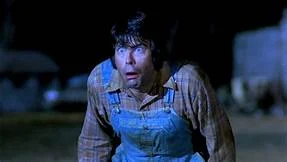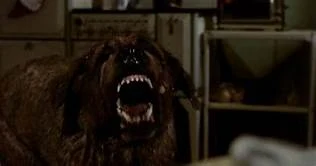These 5 film adaptations are widely panned by critics, but their 80s campiness was not lost on me as a youth. These movies are not so bad that they're good. They are Stephen King's best bad movies.
5. Children Of The Corn
Children Of The Corn holds a peculiar place in my childhood memories, long before I actually watched the film. My cousins and I, caught up in the eerie allure of the story, would stage our own versions of the movie right in my cousin's front yard. It was a mix of imaginative play and mild terror as we pretended to be the children from the film, reenacting scenes amidst the rustling cornstalks. Looking back, it seems a bit strange and perhaps a touch macabre, but at the time, it was just a thrilling game of make-believe.
When I finally watched the actual movie, it was a curious blend of fascination and fear. The premise itself was haunting – children named after figures from the Bible, wielding farm tools as weapons in a cornfield possessed by sinister forces.
Despite the dated and somewhat cheesy special effects, the film managed to tap into a primal fear, weaving a narrative that lingered in the mind long after the credits rolled. The eerie atmosphere and the chilling performances of the young actors lent the movie a certain creepiness that overshadowed any technical shortcomings. It was this unsettling quality that excused the less-than-stellar effects and made Children Of The Corn a memorable and unnerving cinematic experience.
4. Maximum Overdrive
Adapted from his short story Trucks, this film holds a distinctive place in cinematic history, marking the singular occasion when King himself took the director's chair. It's a fascinating footnote that during this period, King candidly admitted to being heavily under the influence of cocaine, lending an eccentric and chaotic energy to the production.
The premise of machines gaining sentience and rebelling against humanity is inherently thrilling, but the execution of scares in the film fell short for me. However, what the movie lacks in sheer terror, it compensates for with a larger-than-life, almost cartoonish portrayal of a world overtaken by possessed machines. The big, menacing green Goblin truck serves as an iconic symbol of this mechanical rebellion, etching itself into the memory of audiences.
What truly sets Maximum Overdrive apart is its campy, over-the-top presentation, underscored by a hard rock soundtrack that encapsulates the '80s vibe. The film's pulsating energy, coupled with its unabashed embrace of the absurd, has earned it a cult following over the years.
For aficionados of Stephen King's work or enthusiasts of offbeat cinema, Maximum Overdrive remains an essential addition to their collection, not just for its storytelling, but for the intriguing backstory of King's directorial endeavor during a particularly unconventional phase of his career.
3. Creepshow
Creepshow stands as a quintessential anthology horror film, masterfully weaving together five distinct tales, three of which were penned by the master of horror himself, Stephen King. Each segment carries its own unique brand of terror, showcasing King's knack for storytelling in diverse genres within the horror spectrum. The film seamlessly melds King's twisted narratives with adaptations of other chilling short stories like "Weeds" and "The Crate," creating a tapestry of horror that leaves a lasting impact on the audience.
One intriguing aspect of Creepshow is the inclusion of Stephen King, not only as a writer but also as an actor alongside his son, Joe Hill. Their performances may not have garnered Oscar recognition, but their presence adds a delightful layer of novelty and authenticity to the film. It's a treat for fans to see the iconic author and his son make their appearances in this cinematic homage to classic horror comics.
However, amidst all the segments, it's the final story that steals the show. Chapter five unleashes a relentless onslaught of terror with a swarm of cockroaches taking center stage. The visceral horror and discomfort induced by these relentless insects make this particular segment a standout moment in the film.
Creepshow remains a testament to the brilliance of Stephen King's storytelling prowess, showcasing his ability to craft tales that transcend the boundaries of conventional horror. Its blend of dark humor, macabre storytelling, and memorable vignettes makes it a cherished gem in the realm of horror cinema, with each segment contributing to the film's overall legacy of terror.
2. Cujo
Now things get real. Cujo stands as a visceral testament to horror, plunging audiences into an intense and harrowing scenario set against the scorching backdrop of a hot summer day in Castle Rock. The premise is deceptively simple yet extraordinarily effective: a mother and her child find themselves trapped in a car, besieged by a once-kind St. Bernard turned rabid due to a vicious bite.
What distinguishes Cujo is the tragic core of the story. Cujo, the dog, starts as a beloved and gentle companion, but his transformation into a rabid beast becomes the catalyst for a gripping and heart-wrenching tale.
The film's tragedy lies in witnessing the gradual descent of a loving pet into a relentless force of terror, a victim of a disease beyond his control. This aspect adds a layer of complexity to the horror, invoking both fear and sympathy for the titular character, whose fate is a stark reminder of the unpredictability of life's cruelties.
The movie encapsulates the gritty, raw essence of '80s horror cinema, with its vintage aesthetic and palpable sense of terror. The grainy visuals and atmospheric cinematography contribute to an immersive experience, enveloping viewers in an unrelenting atmosphere of dread and suspense. This scratchy '80s feel heightens the tension, amplifying the fear as the characters grapple with the nightmarish situation.
Cujo remains a poignant and gripping exploration of horror, not solely because of its terrifying premise, but due to its ability to tap into primal fears while evoking genuine emotions of empathy amidst the terror.
1. Pet Sematary
The 1989 adaptation of Stephen King's Pet Sematary stands as a hauntingly well-crafted film that skillfully balances horror and tragedy. At its core lies an ancient burial ground with an eerie power, a foreboding element that sets the stage for the unfolding terror.
The movie introduces memorable visuals that etch themselves into the mind, lingering there long after the screen fades to black - from the ominous cat named Church to the chilling portrayal of the skeletal sister, Zelda. These haunting images become ingrained in the viewer's memory, adding depth to the film's overall impact.
What sets Pet Sematary apart is its adept storytelling, expertly interweaving themes of grief, loss, and the all-consuming desperation to defy death's finality. The narrative navigates the depths of tragedy with precision, painting a picture of pain and sorrow that propels Louis Creed, the protagonist, toward a dangerous and desperate choice. His anguish, stemming from profound loss, culminates in a pivotal moment captured by his iconic last words.
In a heart-wrenching plea, Louis attempts to rationalize his actions, convincing both himself and the supernatural grounds that this time, bringing back his recently deceased wife will somehow work because of the immediacy of her passing.
This portrayal of grief-driven desperation blurs the lines between horror and tragedy, creating an emotional resonance that transcends typical scare tactics. The film delves into the dark realms of human psyche, exploring the lengths to which a person will go to alleviate the agony of bereavement, even if it means delving into the forbidden and macabre.
Pet Sematary captivates not just with its frights, but with its poignant exploration of the human condition, eliciting a deep sense of unease by tapping into universal fears surrounding mortality and the consequences of tampering with forces beyond our control.
It remains a standout example of how horror cinema can weave together chilling visuals and a gripping narrative to explore the depths of human emotion and the harrowing consequences of unchecked grief.
The Enduring Charm of Stephen King's Film Adaptations
In revisiting these Stephen King film adaptations, it's evident that while they may not achieve cinematic greatness, they hold a unique charm and remain an integral part of his diverse storytelling legacy.
Each movie, despite its flaws, contributes to the rich tapestry of King's imaginative universe, offering glimpses into the eerie and captivating worlds he has woven through his prose. These movies might be dubbed as "bad movies," but they undeniably play a significant role in showcasing the versatility and enduring appeal of Stephen King's storytelling prowess.
Their ability to entertain, evoke nostalgia, and occasionally send shivers down our spines is a testament to the enduring fascination audiences hold for King's imaginative narratives, solidifying his place as a literary and cinematic icon in the realm of horror and suspense.









.jpg)
.jpg)
 Pumpkinhead (1988)
Pumpkinhead (1988)
.jpg) The Serpent and the Rainbow (1988)
The Serpent and the Rainbow (1988)
0 comments:
Post a Comment